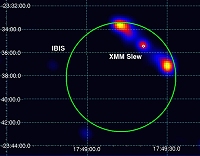New INTEGRAL catalogue expands gamma-ray horizons
7 July 2010
Astronomers have the best idea yet of how the Universe looks in gamma rays after the publication of the fourth INTEGRAL Soft Gamma-Ray Survey Catalogue. The catalogue, which has been constructed from more than 70 million seconds of observing time, now includes significantly more extragalactic sources and is set to orchestrate the future observing programmes of several ground-based and space observatories.Since launch in 2002, INTEGRAL's imaging telescope, IBIS, has been used to assemble four iterations of the soft gamma-ray survey catalogue. Over the years astronomers have utilised IBIS to look at specific sources in the gamma-ray Universe. Whilst these dedicated observations are under way, the telescope also records gamma-ray photons from any source which happens to be within the field of view during the exposure, which can last anywhere from a few days up to a few weeks. As a result the catalogue now contains more than 700 sources.
This broadening of their gamma-ray horizons allows researchers to better probe the secrets of galaxy formation. "Looking over the whole sky at high energies is an excellent way to test our models of how galaxies have formed and evolved throughout the life of the Universe," says Tony Bird, co-investigator for the IBIS imager at Southampton University. It has also had an effect on the relative numbers of different cosmic species which comprise the catalogue. In particular, a little under a third of the catalogue is now dominated by Active Galactic Nuclei (AGNs), accompanied by High Mass X-Ray Binaries (13%), Low Mass X-Ray Binaries (13%) and Cataclysmic Variables (5%).
This still leaves around a third of sources unknown. "There are still a significant number of sources that are unidentified because the comparatively large error circle of INTEGRAL makes it difficult to uniquely identify a counterpart," says INTEGRAL Project Scientist Chris Winkler. While INTEGRAL's wide field of view is good at flagging up the general location of a source, the arc-second accuracy provided by other telescopes, such as ESA's X-ray telescope, XMM-Newton, is needed to pinpoint their exact location. Once this precise location is known, astronomers can start to unveil the true nature of the source using observations over several wavelengths. Bird expects this process will be completed in the near future. "I expect many more of these new INTEGRAL sources to be identified in the coming year, as part of the ongoing multi-wavelength campaign," he said.
A prime example of such a multi-wavelength campaign success is the source IGR J17488-2338. Initially identified by the INTEGRAL catalogue, observations with XMM-Newton revealed it to be an AGN located 10 degrees from the plane of our own Galaxy. Similarly, IGR J13042-1020 was revealed as another AGN by the SWIFT X-ray satellite when it caught a glimpse of the source's core, this time at the heart of galaxy NGC 4939.
 |
 |
|
IGR J17488-2338 (left) and NGC 4939 (right) are two sources discovered in hard X-rays with INTEGRAL, which were later identified with multi-wavelength observations. Credit: ESA | |
In this way INTEGRAL is leading from the front by identifying sources which then demand the attention of the wider research community. In doing so the satellite is moving towards the mainstream of astronomical research. "The numbers of sources that we have now seen with INTEGRAL means that gamma-ray astronomy is able to contribute strongly in many of the current areas of astronomical research and is finally moving away from being 'niche' science," explains Bird.
Related Publications:
Bird, A.J., et al., The Fourth IBIS/ISGrI Soft Gamma-Ray Survey Catalogue, ApJS, 186, 1, 2010. Doi: 10.1088/0067-0049/186/1/1
Contacts:
Christoph Winkler, INTEGRAL Project ScientistResearch and Scientific Support Department
Directorate of Science and Robotic Exploration, ESA, The Netherlands
Email: cwinkler
 rssd.esa.int
rssd.esa.int Phone: +31 71 565 3591
Tony Bird
School of Physics & Astronomy, University of Southampton, United Kingdom
Email: ajb astro.soton.ac.uk
astro.soton.ac.uk
Phone: +44 23 8059 2190


